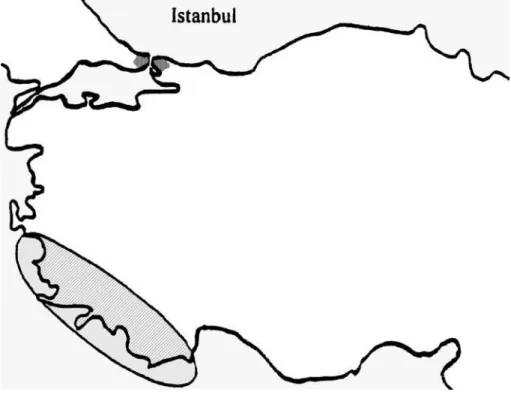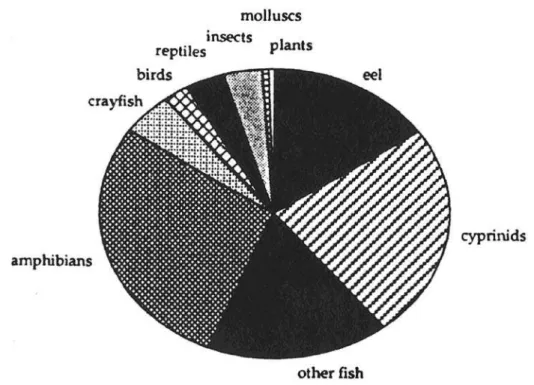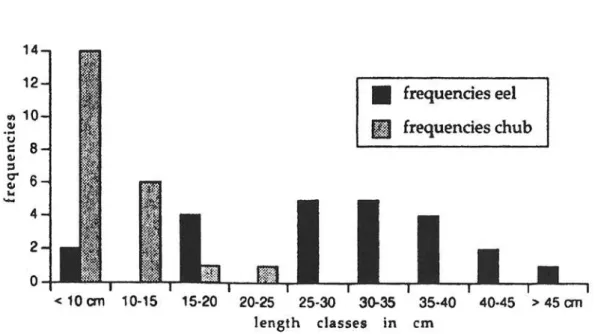- 20 -
A R T I C L E
SOME ASPECTS OF THE FEEDING ECOLOGY OF OTTERS (Lutra lutra)
IN TURKEY
Michael KNOLLSEISEN
Institute of Wildlife Biology and Game Management, University of Agriculture Peter Jordanstr. 76, A- 1190 Vienna, Austria
(Received 20th February 1996, accepted 23th May 1996)
Abstract: Food of otters Lutra lutra was studied by the analysis of 100 spraints collected in Turkey in summer 1994. The aim of the study was to show whether or not there is an impact of otters on local domestic animals and on game species or not. Fish (mostly Anguilla anguilla and Leuciscus sp.) were the most important prey items (55,7 %). Additionally the study showed that otters were feeding on marine fish. Other important prey categories were amphibians (up to 51,9 %), crustaceans (4,8 %), reptiles (up to 9,1 %) and birds (2,4 %). The study showed that there is no reason for condemning the otter as a pest for domestic animals and game species.
Keywords: Lutra lutra, feeding ecology, domestic animals, Turkey
INTRODUCTION
During an otter survey on the west coast of Turkey and its hinterland freshwater rivers in summer 1994, A. Kranz, N. Ziegler and M. Weiss collected about 100 otter spraints (Fig. 1). These spraints were analyzed to determine the impact of otters on local fish, domestic animals and game species. The results of this study should help to resolve the conflict between otter conservationists and local otter poachers (Kranz, 1994). This is one of the first studies on otters in Turkey, where little is known about the status of the species (Mason and Macdonald 1986).
- 21 - METHODS
The 100 dryed otter spraints were soaked for 48 hours in detergent water and washed through a 0,8 mm strainer. The remaining bones, scales and feathers were analyzed with a binocular (6x-50x) and determined with support of reference collections and drawings taken from literature (Brohm, in prep.; Conroy et al., 1993; Engelmann, 1986). Size of the most important fish species in the otter diet was estimated by measuring the vertebrae lengths (Conroy et al., 1993; Wise, 1980). The results were shown as relative frequencies of occurrence, i. e. the frequency of a prey category is presented as a percentage of all prey occurrences (Erlinge, 1967; Conroy et al., 1993; Hansen and Jacobsen, 1992). The spraints of four different sample areas were evaluated separately. The spraints of the other study sites formed together the fifth sample.
RESULTS
Table 1: Food of otters in Turkey (results are shown as relative frequencies of occurrence); N= number of spraints; n= number of occurrences; total number of spraints = 100
Turkey 1994 Hisaronu N = 15
Kizil De N = 15
Gelibolu N = 15
Akcarpinar N = 21
Rest N = 34 Prey
Categories
n Rel. Freq. %
n Rel. Freq. %
n Rel. Freq. %
n Rel. Freq. %
n Rel. Freq. % Trout
(Salmo trutta)
1 3.7 1 3.7 0 0 1 2.4 0 0
Perch (Perca fluviatialis)
1 3.7 0 0 0 0 2 4.7 4 8.2
Perch, not def.
0 0 0 0 0 0 0 0 1 2
Eel (Anguilla Anguilla)
10 3.7 3 11.1 0 0 4 9.5 9 18.4
Chub (Leuciscus sp.)
8 29.6 2 7.4 9 4.1 0 0 4 8.2
Cyprinids, not def.
1 3.7 2 7.4 2 9.1 0 0 7 14.2
Mugil sp. 0 0 0 0 0 0 2 4.7 0 0
Roccus labrax
0 0 0 0 0 0 4 9.5 0 0
Other sea fish
0 0 0 0 0 0 14 33.3 0 0
Fish, Total 21 77.7 8 29.6 11 50.1 28 66.7 25 51
Amphibians 6 22.3 14 51.9 4 18.2 8 19 16 32.7
Birds 0 0 2 7.4 0 0 1 2.4 1 2
Crustaceans 0 0 0 0 3 13.6 4 9.5 1 2
Reptiles 0 0 0 0 2 9.1 0 0 4 8.2
Insects 0 0 2 7.4 1 4.5 1 2.4 2 4.1
Molluscs 0 0 1 3.7 0 0 0 0 0 0
Plants 0 0 0 0 1 4.5 0 0 0 0
- 22 -
Figure 2: Relative frequencies of occurence of the different otter prey categories in Turkey
In 100 analysed spraints 167 feeding remains belonging to 16 prey categories were identified (see Tab. 1). Fish (55.7%) and amphibians (28.7%) were the most important prey categories (Fig. 2). At the first study site (Hisaronu, n = 15) most of the diet was
Anguilla anguilla (37%), Leuciscus sp. (29.6%) and amphibians (22.3%). Apart from the low occurrences of trout, perch and cyprinids were found in the spraints. This site provided the highest portion of fish of the whole study area (77.7%). On the River Kizil De amphibians were the dominant prey (51,1%). Other prey included birds (7.4%), insects (7.4%) and molluscs (3.7%). The fish species with the highest occurrence were again eel (11.1%) and chub (7.4%). The total portion of fish was 29.6%, the lowest in the whole study. On the River Gelibolu the total fish portion was 50% (mostly small juvenile chubs 41%). The rest of the prey were amphibians (18.2%), crayfish (13.6%), reptiles (9.1%) and insects (4.5%). Gelibolu was the only study site with no eel. In one spraint large undigested plants were found. Akcarpinar was the only study site (close to the sea) where the presence of sea-fish (47.5%; 9.5% of them were Mugil sp. and 4.7% Roccus labrax) was recorded. The other 33.3% were other unidentified sea-fish (probably one or two different species). Freshwater fish such as eel (9.5%), perch (4.7%) and trout (2.4%) were found in this site. Apart from fish, amphibians (19%), birds (2.4%), crayfish (9.5%) and insects were found in the spraints. The total number of prey categories (10) was the highest of all five sites. In the remaining spraint samples amphibians (32.7%), reptiles (8.2%), birds (2%), crayfish (2%) and insects (mostly large waterbeetles, 4.1%) were found. Eel (18.4%), chub (8.2%), trout (8.2%) and unidentified cyprinids (14.2%) formed a total fish portion of 51%.
- 23 -
Figure 3: Length frequency distribution of 23 eel (Anguilla anguilla) and 22 chubs (Leuciscus sp.) eaten by otters in south-west Turkey.
DISCUSSION
- 24 -
cyprinids in the otter diet it is not allowed to infer directly on a impact of otters on juvenile fish stock; other influences on small fish like sudden floods or drying of ditches or river stretches are maybe much more catastrophic for juvenile fish than the feeding of otters. Only the connection of otter predation and abiotic influences can become problematic for fish populations (e.g. otters entering in small almost dry ponds or ditches). For further information on the impact of otters upon their prey or upon domestic animals a more detailed study would be necessary.
Table 2: Otter diet in the Mediteranean area in comparison to the results of the current study: number of spraints (N) and relative frequencies of occurrence (Prigioni et al., 1981; Macdonald and Mason, 1982; Arcá and Prigioni, 1983; Fasano 1994; Adrian and Delibes, 1985) (Spain* = two different study sites)
Study area N fish amphibians reptiles crustaceans birds insects
Albania 33 50.0 22.4 6.9 10.3 0.0 10.3
Greece 80 54.9 20.9 0.0 0.0 6.6 9.9
Central Italy ? 74.2 5.0 13.6 ? ? ?
Southern Italy 172 76.5 17.2 2.0 0.0 2.3 0.0
Spain* 334 67.2 12.4 3.1 0.0 0.2 15.0
Spain* 264 37.8 7.2 0.3 31.5 0.3 21.9
Turkey 100 55.7 28.7 3.6 4.8 2.4 3.6
ACKNOWLEGDEMENTS - I am very grateful to N. Ziegler and M. Weiss from AGA for the supply
with the spraints (collected partly by A. Kranz) and to AGA (Aktionsgemeinschaft Artenschutz e. V., Germany) for the financial support.
REFERENCES
Adrian, M.I., Delibes, M. (1987). Food habits of the otter (Lutra lutra) in two habitats of the Donana National Park, SW Spain. J. Zool. Lond., 212: 399-406
Arcá, G., Prigioni, C. (1987). Food of the otter on the Fiora river (Central Italy).
Acta Theriol. 32: 134-140
Brohm (in prep.): Microscopic identification of feather-remains after collisions between birds and aircraft, Zoologisch Museum Amsterdam & Royal Netherlands Air Force
Conroy J.H.W., Watt, J., Webb, J.B., Jones, A. (1993). A guide to the
identification of prey remains in otter spraints. Occasional publication No.16, The Mammal Society, London
Engelmann, W.E. (1986). Lurche und Kriechtiere Europas. DTV Enke, p.420
Erlinge, S. (1967). Food habits of the fish-otter Lutra lutra L. in South Swedish habitats. Viltrevy4: 371-443
Fasano, R. (1991). La lontra europea (Lutra lutra L.) nel bacino del fiume Sele: analisi della distribuzione e della nicchia trofica. Thesi di laurea, Univ. degli studi di Napoli
Hansen, H. ,Jacobsen, L. (1992). Aspekter af odderens (Lutra lutra L.) fodebiologi i Danmark, Specialerapport, Arhus Universitet
Knollseisen, M. (1995). Aspects of the feeding ecology of the Eurasian otter Lutra lutra in a fispond area in Central Europe. Dipl. Arbeit Univ. Wien
Kranz, A. (1994). Some comments on the otter (Lutra lutra) in Turkey. IUCN Otter Spec. Group Bull., 10: 30-31
Kruuk, H., Moorhouse, A. (1990). Seasonal and spatial differences in food selection by otters (Lutra lutra) in Shetland. J. Zool. Lond.,221: 621-637
Macdonald, S. M., Mason, C.F. (1982). Otters in Greece. Oryx, 16: 240-244
Mason, C.F., Macdonald, S.M. (1986). Otters - Ecology and Conservation.
Cambridge University Press, pp. 236
Muus, B.J., Dahlström, P. (1990). Süwasserfische Europas. BLV, pp. 224
Prigioni, C., Bogliani, G., Barbieri, F. (1986). The otter Lutra lutra in Albania. Biol. Cons., 36: 375-383




